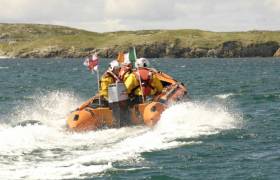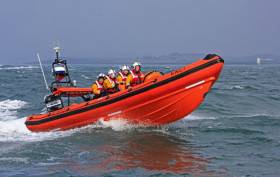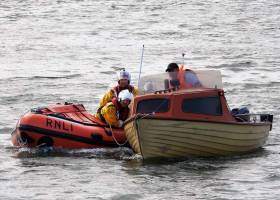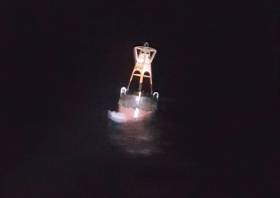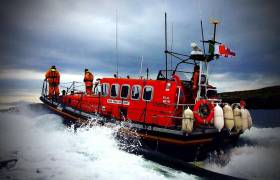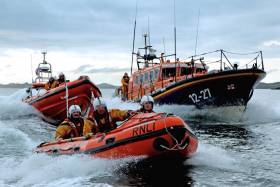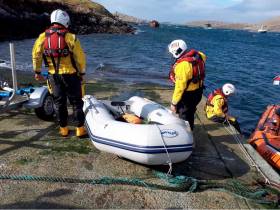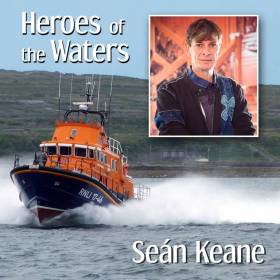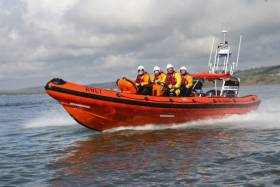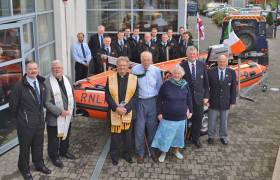Displaying items by tag: Clifden
Clifden Lifeboat Recovers Seven Cut Off By Tide
#RNLI - Clifden RNLI’s D class lifeboat Celia Mary was on exercise at Glassilaun Beach for the annual sports day on Sunday (12 August) when it was alerted to a group of people cut off by the tide.
The inshore lifeboat proceeded to Illamore Island after the alert at 3.50pm. On approaching the island, they saw a woman up to her chest in the water holding onto a child who was visibly in distress.
The six-year-old child was immediately brought onboard the lifeboat followed by her mother. Both were wet, cold, frightened and extremely happy to finally be in safe hands.
Both casualties were given survivors lifejackets and a crew member gave the child his warm helmet. Her mother had a jacket which she wrapped around her to keep the wind off.
The lifeboat crew spotted one more adult and four children stranded on top of some rocks. They were also cut off by the rising tide, but not in immediate danger.
The woman recovered to the lifeboat indicated that she was the mother of two of the children still on the rocks. The crew brought another child on board the lifeboat, placing a lifejacket and helmet on her.
After that the lifeboat proceeded to the beach where the crew collected the casualties’ belongings, leaving crew member David O’Reilly with the four still cut off by the tide.
The casualties on board the lifeboat were then returned to the safety of the shore, and went back for the remaining four. The callout was complete at 5pm and the lifeboat was ready for service from Clifden at 7pm.
Elsewhere, Arklow RNLI’s lifeboat was launched at 2.04pm yesterday (Monday 13 August) following a pager alert to a kitesurfer and windsurfer both reported to be in difficulty south of Mizen Head.
With strong tides in the area, Arklow RNLI proceeded to the scene. Upon arrival, the lifeboat crew were made aware that the casualties had made it ashore safely and the lifeboat was stood down.
Following the callout, Mark Corcoran, Arklow RNLI’s volunteer press officer and community safety officer, said: “Thanks to the quick thinking of the local beach lifeguard, our lifeboat was launched early enough to be on scene to assist if necessary.
“People should never hesitate in calling us out. Before going out people need to check the tides and weather and make themselves aware of local hazards and always carry a mean of calling for help.”
#RNLI - Portaferry RNLI’s volunteer crew were paged yesterday afternoon (Saturday 11 August) to go to the aid of two people stranded on Guns Island off Co Down.
The lifeboat launched at 3:20pm in overcast weather with good visibility and a Force 4 south-easterly wind but a rough sea state, and on arrival on scene 20 minutes later it was raining with poor visibility.
Newcastle, Bangor and Portaferry coastguard rescue teams were also in attendance, assisting from the shore.
The RNLI crew approached the scene where they rescued the two people and their dog from the island, where they were stranded after their six-metre punt got into difficultly and was destroyed on nearby rocks.
The casualties were taken to Ballyhornan Beach where they were transferred to the care of the coastguard rescue teams on shore.
Elsewhere, Clifden RNLI added to their busy August with a callout to a yacht with engine trouble both of Slyne Head on Friday afternoon (10 August).
A light Force 2 north-westerly wind made the yacht’s passage to Clifden slow going under sail alone. The Clifden lifeboat crew established a tow to Clifden Bay, which took over an hour, and the D-class lifeboat aided in mooring the yacht.
“Once on the mooring, a rope could be observed caught underneath the yachts hull and an attempt was made to release it. This proved unsuccessful but explained how the yacht had lost mechanical propulsion,” said Clifden RNLI coxswain David Barry.
Wicklow Lifeboat Aids Angling Boat With Mechanical Failure
#RNLI - A small angling boat with one person on board was towed to safety by Wicklow RNLI after it got into difficulty near Wicklow Head on Wednesday evening (8 August).
The angler had earlier departed from Wicklow Port for a day’s fishing along the coast, but was unable to get the engine into gear to return to the harbour.
The inshore lifeboat launched shortly after 6pm with helm Vinnie Mulvihill and crew David O’Leary and Graham Fitzgerald, and located the drifting craft near Wicklow Head eight minutes later. Weather conditions at the scene were calm with a northerly wind force three.
The angling boat was taken in tow back to Wicklow Harbour and the angler was landed safely ashore.
Elsewhere, Clifden RNLI continued what’s been a busy August when the volunteer lifeboat rescued a boy separated from his kayak at Omey Island earlier on Wednesday afternoon.
The youngster and his friend were holidaying on the island in Claddaghduff with their families, who raised the alarm when one of the boys was seen in the water with his friend trying to help him.
Following the coastguard request after 2.30pm, the Atlantic 85 lifeboat launched from Clifden while the D Class lifeboat travelled by road and was launched at Claddaghduff. Winds were Force 6 and gusting to 7 at the time.
When the Atlantic 85 reached the scene, they found people waving from the eastern shore of the island and saw that the two boys involved had made it ashore to another beach in the area, where some other visitors were assisting them.
Clifden RNLI helm Thomas Davis manoeuvred the lifeboat close to the shore and crew member James Mullen then swam to attend to the boys before reuniting them with their families. They were cold and shaken after the ordeal but otherwise unharmed.
Speaking after the callout, Mullen said: “We were really glad to have been able to assist these lads and their families today and always encourage anyone concerned to raise the alarm as quickly as possible.
“Conditions at sea in this area can change rapidly even for experienced water users and we are always on hand to help where we can.”
The RNLI advise all kayakers to always carry a means of calling for help and to keep it in reach at all times.
More recently, Carrybridge RNLI’s rescue water craft and inshore lifeboat Douglas Euan & Kay Richards, were requested to launch by Belfast Coastguard to assist a man who was disorientated whilst navigating Tamlaght Bay in Upper Lough Erne in the early hours of this morning, Friday 10 August.
And Larne RNLI’s all-weather lifeboat and inshore lifeboat crews recently carried out a training exercise to simulate a casualty care and extraction scenario.
Large Marker Buoy Found Adrift By Clifden Lifeboat
#RNLI - Clifden RNLI’s all-weather lifeboat launched just after midnight on Monday (30 July) to reports of a flashing light spotted off the Connemara coast.
The bright flashing lights had been seen from the shore north-west of the Aughris peninsula, and the Cleggan Coast Guard requested the RNLI to launch to investigate. It was a low tide at the time of launch with a Force 5-6 wind blowing.
On arrival at the scene, the RNLI crew saw that the light was coming from a cardinal marker buoy navigational aid which had become detached from its original location and was now adrift.
Once they informed the coastguard, the volunteer crew comprising coxswain John Mullen, David O’Reilly, Ian Shanahan, Robert King, Thomas Davis and Owen Hayes returned to Clifden at around 3am.
Speaking following the callout, lifeboat navigator Hayes said: “This was a large south-west cardinal marker and once we determined the cause of the lights seen from shore we informed the coastguard, who then recorded it as a navigational hazard for other seagoing vessels.”
#RNLI - Clifden RNLI’s all-weather lifeboat was launched on Tuesday evening (17 July) for the medevac of a young woman who sustained a serious head injury in a cycling accident on Inishbofin.
Arriving at the island’s harbour at 8.53pm, lifeboat crew members Joe Acton and Daniel Whelan met the island nurse, carried out an assessment and then transferred the casualty, a visitor to the island, on board.
The lifeboat proceeded to Cleggan where an ambulance was waiting to transfer the casualty to University College Hospital Galway. The crew continued to monitor her condition throughout the crossing.
“The casualty in this case was certainly in need of urgent medical treatment and we were glad to have been able to help to transfer her quickly to the mainland,” said Clifden RNLI coxswain James Mullen.
“The summer population of Inishbofin increases massively due to tourism and as a result these sorts of situations while rare can arise. The presence of the RNLI all-weather boat in the area has certainly helped for these kinds of incidents.”
Earlier in the week, the Clifden all weather boat had been launched to another medical emergency in the island but stood down after the coastguard helicopter reached the scene first.
Elsewhere on Tuesday evening, Skerries RNLI were tasked to a motorised RIB that had suffered electrical failure north of Lambay Island.
Shortly after 9pm the Atlantic 85 inshore lifeboat launched with Joe May at the helm and crewed by Sheila May, AJ Hughes and Jack Keane.
As the lifeboat neared the island, the casualty vessel fired a white parachute flare to alert of their whereabouts in fading light.
The vessel, with four men and one woman on board, was taken under tow by the lifeboat and returned to the safety of Rush Harbour.
“Thankfully we were able to locate the casualty quickly and all on board were well and in good spirits,” said Skerries RNLI volunteer lifeboat press officer Gerry Canning.
“Our volunteers are always ready to respond and we would always advise anyone going to sea to carry more than one means of contacting the shore, and, if needed, to make the call for help early.”
Fisherman Dies After Capsize Off Cruagh Island
#RNLI - A fisherman has died after his boat capsized off Cruagh Island near Clifden in Co Galway yesterday evening (Wednesday 23 May).
Volunteers from Clifden RNLI were involved in the search and rescue operation for the man after the alarm was raised by another fisherman shortly before 5pm.
Both Clifden RNLI’s Atlantic 85 inshore and the Mersey class all-weather lifeboats launched and made their way to the scene off Cruagh Island, some seven miles from the station.
The Irish Coast Guard’s Rescue 115 helicopter from Shannon was also tasked.
Once on scene, a search commenced and the helicopter crew spotted the casualty in the water and guided Clifden RNLI’s Atlantic 85 lifeboat to him.
The man was then transferred into the lifeboat where the lifeboat crew began to administer casualty care.
He was subsequently brought to Clifden lifeboat station where he was transferred into the care of ambulance paramedics and then airlifted by helicopter to hospital where he died as a short time later, as Independent.ie reports.
Speaking this morning following the tragic news, Clifden RNLI lifeboat operations manager John Brittain said: “All at Clifden RNLI would like to extend their sincere sympathies with the family of this man. Our thoughts are very much with them at this time.”
#RNLI - Minutes after participating in the local St Patrick’s Day parade on Saturday 17 March, Clifden RNLI joined a full-scale search and rescue operation for two spear divers reported missing.
Clifden’s all-weather and inshore lifeboats were tasked alongside Achill RNLI, the Sligo-based Irish Coast Guard helicopter Rescue 118 and the Cleggan Coast Guard Unit in the search for the two men that had left Rossroe pier that morning in a small inflatable boat to go spear fishing on the north side of Killary Harbour. The men had not been since that morning.
At 1.12pm, Clifden RNLI’s all-weather lifeboat Fisherman’s Friend was prepared for launch with coxswain Alan Pryce, mechanic Robert King, navigator Owen Hayes and crew members Tom Davis, Kieran Folan and David Coyne.
The D class inshore lifeboat Celia Mary was transported by road to Rossroe and was crewed by helm James Mullen and crewed by Brian Ward, David O’Reilly and Ian Shanahan. Shore crew volunteer Fergal Conneely drove the Land Rover with the inshore lifeboat in tow to launch at Rossroe pier.
Clifden’s inshore lifeboat shortly after arrived on the scene joining Rescue 118. The crew were briefed by the local fisherman who had reported the spear divers missing.
When he was out fishing about 90 minutes previously, he had seen them spear fishing on the north side of the bay with a small inflatable with an outboard engine. However, he hadn’t seen them or their inflatable since, and as their van was still on the pier, with the weather deteriorating, he decided to call for assistance.
Weather conditions had a north-easterly Force 5-6 wind as Rescue 118 were conducting an aerial search of the bay. The lifeboat crew then spotted a small inflatable with two people onboard trying to hang onto a barge.
Clifden RNLI helm James Mullen said: “I informed Rescue 118 of the possible sighting and they proceeded to the area with us. When we arrived on scene, the two men informed us that they were the two missing spear divers.
“Their engine had broken down and they had tried to swim the across the bay with their boat but it had become swamped. Their legs had cramped and they were both exhausted. We towed them back to the pier at Rossroe and helped them recover their boat at 2pm.”
Clifden RNLI lifeboat operations manager John Brittain added: “The inshore D Class lifeboat Celia Mary, which was just named in a ceremony last year, has once again proved how much of a valuable asset it is to our station.
“We are delighted to have been able to respond and bring these people to safety and are also very thankful for the vigilance of the local fisherman who raised the alarm and potentially avoided a much worse outcome today.”
Elsewhere on Saturday, Howth RNLI launched its all-weather lifeboat to reports of an upturned kayak spotted in rough seas off the nose of Howth.
A member of the public, while out walking on Howth Head, spotted what appeared to be a yellow upturned kayak just off the nose of Howth in very rough water and raised the alarm with the Irish Coast Guard, sending them a picture taken with their smartphone.
Howth RNLI was immediately tasked to investigate, with crew pagers sounding at 5.45pm and the lifeboat launched within 12 minutes. Weather conditions saw a very rough sea state in Force 6-7 easterly winds.
Despite the poor conditions, the kayak was quickly located and brought aboard the lifeboat. It looked like it had not been used for quite some time and had been adapted to support a floating structure. The lifeboat completed a search of the area and returned to base.
Speaking following the callout, Howth RNLI station mechanic Ian Sheridan said: “We have to compliment the member of the public for their quick action. While in this case it was thankfully a false alarm, the accuracy of their report to the coastguard allowed us to find the reported vessel and conduct a search.”
Galway Singer Sean Keane To Honour Clifden RNLI’s ‘Heroes Of The Waters’
#RNLI - Renowned Galway singer Sean Keane is set to make a welcome return to Clifden this February for a special evening of song and entertainment dedicated to the lifesaving work of the RNLI.
In the intimate setting of the Church of Ireland in Clifden at 8pm on Saturday 10 February, Sean and friends will launch a new song ‘Heroes of the Waters’ in tribute to those who volunteer to provide lifeboat services at sea.
A limited-edition CD with three tracks will also be on sale on the night for €5 with proceeds going to Clifden RNLI, which saw the naming of its latest lifeboat Celia Mary last October.
Tony Hiney, RNLI community fundraising manager, said: “We are absolutely delighted that a singer of Sean’s stature and popularity has decided to make such a wonderful musical tribute to our lifeboat volunteers.
“We wish to thank him and his team for their support and we look forward to a wonderful evening celebrating our mutual appreciation and support.”
Tickets for Sean Keane’s ‘Heroes of the Waters’ special concert are available from The Station House Hotel and The Celtic Shop, Main St, Clifden.
Youghal Lifeboat Assists Fishing Boat Taking On Water
#RNLI - In the East Cork lifeboat station’s first callout of 2018, Youghal RNLI was requested to launch at 1.02pm on Wednesday 10 January to reports of a fishing vessel that was taking on water.
The lifeboat proceeded to the location of the fishing boat, with one onboard, near Whiting Bay. Conditions saw a choppy sea state at the time, with a moderate southeasterly breeze.
Helmed by Erik Brooks and with crew members Liam Keogh, Mick Brooks and Eddie Hennessy onboard, the lifeboat reached the vessel and quickly assessed the situation to find a good deal of water onboard.
Two of the crew boarded the boat with a salvage pump and started to pump the water overboard.
Waterford’s Irish Coast Guard helicopter Rescue 117 arrived on scene to give air assistance and stayed in the area until the vessel was returned safely to Buttimer’s Quay and Youghal Coast Guard.
Speaking following the callout, Youghal RNLI helm Erik Brooks said: “The skipper did the right thing by calling for help quickly today and we were delighted to bring the fisherman and boat to safety.
“We would remind anyone planning a trip to sea to always respect the water. Always carry a means of communication with you when you are on the water and remember to let someone ashore know when you leave and when you are due back.”
In other Irish lifeboat news, Clifden RNLI's all-weather lifeboat Fisherman’s Friend was requested to launch at 8.50am on Tuesday morning (9 January) to investigate reports of a white light west off Eeshal Island in Co Galway.
At 9.10am, the all-weather lifeboat was underway to investigate with six volunteer crew on board and in difficult weather conditions of 3-4 metre seas and a south easterly Force 7-8 wind.
The boat proceeded to Eeshal Island and conducted a thorough search around Omey Island, Aughris Point and Cruagh Island.
When nothing was found after some time, Malin Head Coast Guard was satisfied that the light seen was most likely from a 25m fishing vessel that had passed by the area that morning and did not indicate a vessel in difficulty.
Clifden RNLI coxswain James Mullen said later: “This call was reported with good intent and we would like to thank the member of the public for their vigilance.
“Given the prevailing weather conditions this morning, the all-weather boat was an excellent asset and well done to all the crew for assembling and launching so quickly.”
Clifden RNLI Name New Inshore Lifeboat ‘Celia Mary’
#RNLI - Clifden RNLI officially named its new D class lifeboat Celia Mary at a special ceremony and service of dedication held yesterday (Saturday 21 October) in the Connemara coastal town.
The honour of handing over the lifeboat and officially naming her went to the donor Peter Ross, husband of the late Celia.
He was accompanied at the ceremony in the Station House Hotel by his family and Celia’s best friend Rea Hollis, who has made a generous donation towards the running costs of Clifden Lifeboat Station.
Celia, who was from East Sussex but was of Irish descent, died three years ago shortly after her 79th birthday. She had always wanted to fund a lifeboat.
A much-loved wife and mother of five children, Celia spent many years living self-sufficiently and keeping cows and sheep. She had a great sense of humour and her kitchen was the focal point of her village.
Her idyllic life came to an end when rheumatoid arthritis took hold. But despite suffering from subsequent ill health, this did not stop her from becoming a respected antiques dealer until what has been described as her indomitable spirit succumbed and she passed away.
During the ceremony, Niamh McCutcheon, a member of the Irish Council of the RNLI, accepted the lifeboat on behalf of the charity from Peter Ross, before handing her over into the care of Clifden Lifeboat Station.
During her address, McCutcheon praised the efforts of all those who supported the work of the station.
“In 2017, Clifden RNLI has been requested to respond to 17 call outs, with a total of 26 launches, bringing 18 people to safety between the three different lifeboats on station here. You cannot put a price on the impact that has on people’s lives, whether they are volunteers or casualties.
“Our lifesavers could not have answered those calls for help without the support they receive from fellow volunteers on the shore: the fundraisers, the launch crew and the station management. In fact the whole of the RNLI depends on those people who represent our charity in the community.”
Lifeboat operations manager John Brittain accepted the lifeboat on behalf of Clifden RNLI ahead of the blessing in a service of dedication led by Father James Ronayne and the Very Reverend Stan Evans. The lifeboat was then officially named by Peter Ross.
Brittain said the event was a special occasion for the lifeboat station, adding that the crew were most grateful to Peter for his generous gift in memory of his wife which had funded the lifeboat.
“Celia always wanted a lifeboat, and now she has one in Clifden,” he said. “While her lifeboat may be a little far from her family, we have been told by her loved ones that Celia, who was of Irish descent, would have revelled in the beauty of Galway, Connemara and the Atlantic coast.”
The D class Celia Mary replaces the Grainne Uaile which served Clifden RNLI for the last 10 years. During that time, the lifeboat launched 62 times, bringing 20 people to safety.
Originally introduced in 1963, the D class has evolved into a highly capable modern lifeboat. It is the workhorse of the RNLI’s fleet and is ideal for working close inshore, near rocks or in shallow water in moderate conditions. It can be righted by the crew if it capsizes and is also part of the RNLI flood rescue team’s fleet of boats.
She comes into her own for searches and rescues in the surf, shallow water and confined locations - often close to cliffs, among rocks and even inside caves.
The RNLI established a lifeboat station in Clifden in early 1988 when a C class lifeboat was put on service for one season’s evaluation. The following year, Clifden RNLI became fully operational as a summer season-only lifeboat station.
In 1997, an Atlantic 21 lifeboat was placed on service and a new boathouse for the lifeboat and a tractor was completed in August 1998. A new D class lifeboat was placed on service in May 1998, and the following year it was joined by a new Atlantic 75 B class lifeboat which remained stationed until June 2013 when it was replaced by the Atlantic 85 named Joyce King.
A crowd of well wishers turned up to see the lifeboat officially named, with a bottle of champagne poured over the side of the boat before it launched at the end of the ceremony.
Among the guests on the platform party were Pearse Hyland, chair of the Lifeboat Management Group, who welcomed guests and opened proceedings, and inshore lifeboat mechanic Andy Bell, who gave a vote of thanks and closed proceedings.


























